Caving (and mine exploring) is an unusual outdoor pursuit in that it's time spent almost entirely in darkness. As such you need a good source of light - usually a torch.
After 10 years of caving (and mine exploring) I now feel that I have earned the right to give my unsolicited opinion on what makes a good caving torch.
TLDR: Caving introduces some niche requirements for torches. Feel free to skip to my recommendations.
Considerations
Before I make some recommendations, let's look at some things that you need to consider when choosing a caving light. I've split this up into three lists; must haves, nice to haves, and don't wants.
Must haves
-
Brightness: a caving torch must produce enough light to cave with. This isn't actually all that much light, in fact early cavers and miners used candles as their only source of light. A candle has a luminous flux (good luck with that rabbit hole!) of about 12.5 lumens. They had a horrible time though, so let's go for a minimum brightness of 10x that: 125 lumens.
However... lumens alone aren't all that useful as a metric, as it doesn't consider the area that this light is spread across. A candle spreads a small number of lumens over a large sphere, whereas a laser pointer crams it all into a tiny spot. Most torches have a tolerable beam-shape, though, so I'll relegate beam shape to the "nice to haves" section.
-
Robustness: you (really!) need your torch to survive your trip. For me, this means it has to be waterproof. Thankfully we have a nice ingress protection standard that allows us to directly compare waterproofness. As you may well be wading, swimming, crawling through puddles, or even going entirely underwater for sumps and ducks, I think IPX7 is a good minimum.
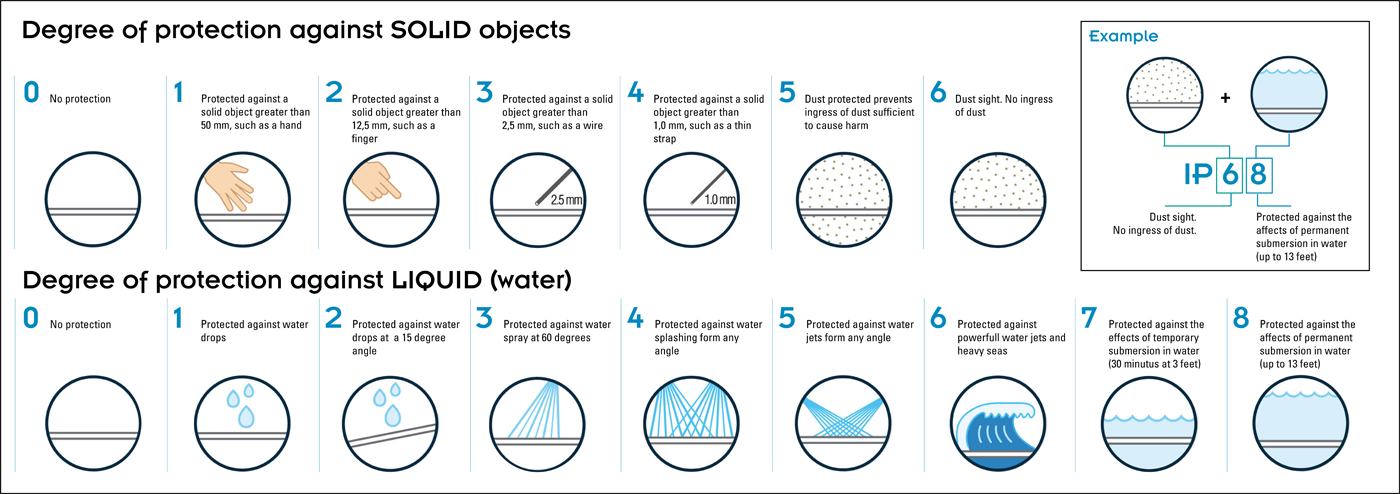
Robustness should also include impact resistance. Now we do have a standard for this too, but it's not very human readable, and has such hasn't seen very widespread adoption. Instead you have to judge robustness on manufacturer ~lies~ claims, user reviews, and an instinctive assessment of the material and design of the product itself.
-
Head mount: you need your hands when you're caving, so your torch has to live on your helmet. However, I have chosen to use "head mount" here, because your backup light(s) shouldn't rely on you still having your helmet - what if you've dropped it down a pitch and smashed it to smithereens?
Head mount also encompasses weight and bulk as you have to be able to wear it on your head for hours at a time. I don't know what my limits are for weight really, except having worn a 160g headlight (inc. batteries) once or twice I wouldn't want to exceed that by much.
-
Friendly UI: so that you can access all those nice brightness modes. This is a matter of preference, but it's really important that your torch is actually usable and safe, so it deserves to be in the must haves. Just check out how complicated this flowchart is describing how the Anduril 2 UI works:
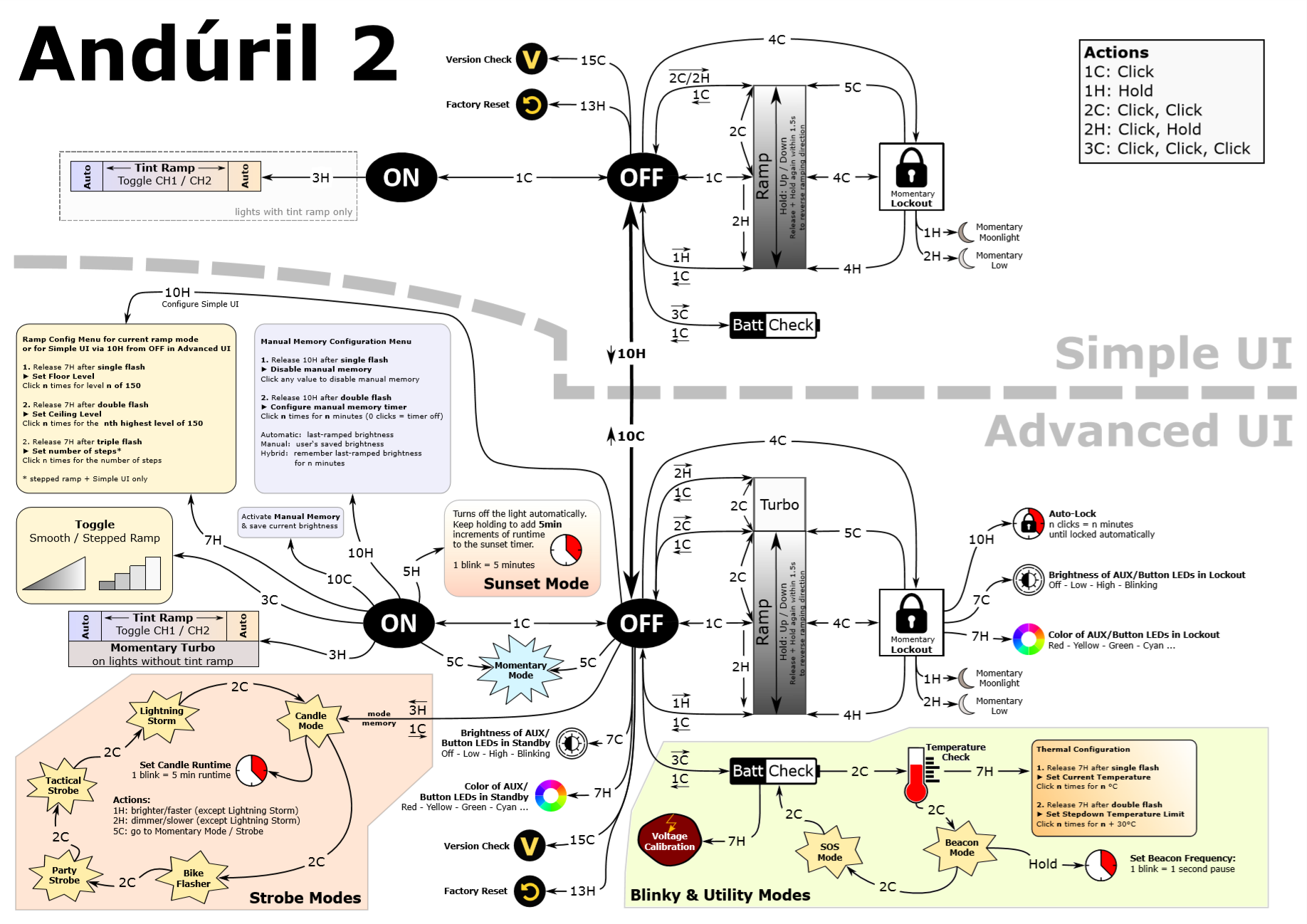
Now I happen to love Anduril 2, but I'm a bit of a torch nerd, and I only really ever use "simple mode" unless I'm configuring something about the torch. Who uses the auto-turn-off timer on their headtorch!?
However, some UI features that I'd definitely highlight as must haves are:
-
Lockout: so you don't burn a hole in your tackle sack/pocket/leg.
-
Brightness ramps: a sensible range of brightness options is important - you don't want to be stuck having to choose between maximum brightness that's tearing through your batteries really quickly, and a moonlight mode that you can't quite do anything by. Really fancy UIs allow you to customise this, which is clever, but make sure this functionality doesn't require a complex cheat-code-like button press combination to access.
-
Nice to haves
-
Beam shape: a caving torch needs to illuminate where you're pointing it, but also the area around that, ideally at quite a large radius and soft edge so that you preserve your peripheral vision. Let's have a look at an example to illustrate this:
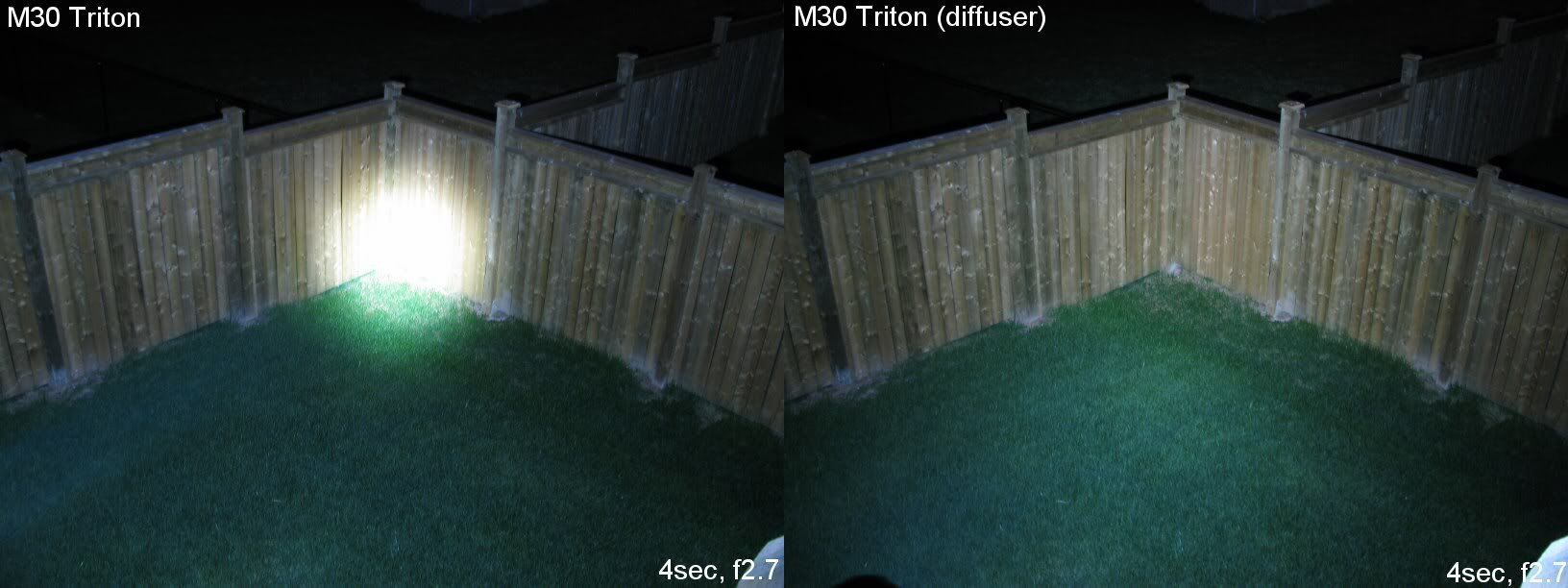
Here we have some beamshots shamelessly stolen from CandlePowerForum's user "selfbuilt". These illustrate the same torch, the Olight Triton M30, with and without the diffuser fitted. The nice thing about this comparison is that the number of lumens is going to be approximately the same (the diffuser will reduce it slightly), but the hugely altered beam shape really changes the luminous intensity produced.
You can see how a very tight and discrete beam edge would be a nightmare to cave with. On the other hand, the soft and wide beam edge given by the diffuser means you're not blinded in the centre of your vision, and you can still see what's happening around you. That being said, you don't want a completely uniform beam, instead having it a bit brighter in the centre where you're directly looking (and where you have more cones than rods) is definitely a good thing.
-
Beam colour: there are two main things to consider here (ignoring tint as it's so hard to actually find any data on this for most lights/emitters);
-
Colour temperature: this is how warm (red) or cold (blue) the light is. A warm light is generally nicer to cave by than a cold one. You may compromise on colour rendering and LED efficiency if you go for a warm light, but this is generally not significant for our use. I lean towards around 4000K, so it's warm but not disconcertingly so if you're caving with others.
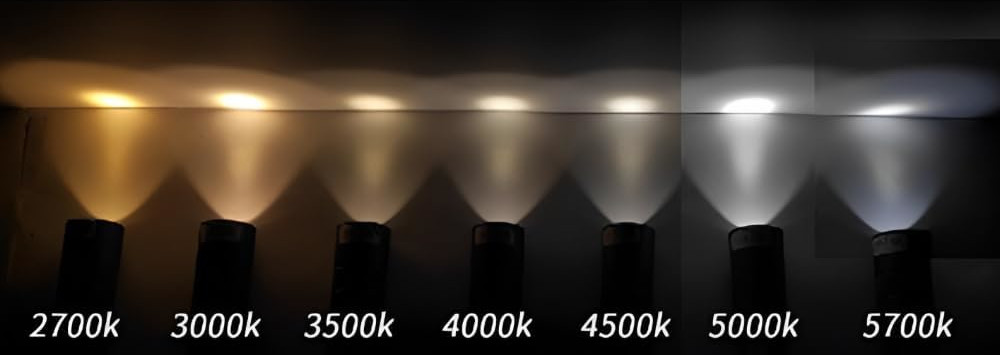
Here's another shamelessly stolen image, this time from CandlePowerForums user "Guitar Guy". It really demonstrates how big a difference the colour temperature can make to the feel of a torch.
-
Colour rendering: this is how accurately a light source emulates that of a hot bit of metal (like our sun), and therefore how faithfully colours will be rendered. You want a CRI as close to 100 as possible, but anything over 85 is pretty good.
-
-
Replaceable batteries: these days Li-ion batteries are so high capacity that you're unlikely to have to switch them out on a trip, but if you're still rocking a Petzl Pixa with NiMH AAs then you might. So try and choose a light that has replaceable batteries, and therefore...
- 18650s: Why? They're high capacity, high discharge, rechargeable, widely available, and a good form factor. This is the recommendation that I'm most likely to change as battery chemistry evolves, but for now I'm comfortable with it.
-
Top button: pressing a button on the end of a headlight is a bit tricky, so a side/top button is nicer. This really isn't that big a deal though.
Don't wants
-
Unnecessary features: anything that isn't producing light may be an unnecessary feature. It is something else to go wrong, something else to complicate use, something else to have to cram in a small package on your head increasing its size and weight. This includes:
-
Secondary colours: people love their red LEDs, but you don't need it for caving.
-
Flashing lights: do I even have to justify this?
-
Onboard charging: good charging circuitry isn't at all straightforward, and most manufacturers really cut corners here. You might see little rubber flaps over charging ports (inevitable water ingress point), magnetic charging systems (which ruin your compass bearings when surveying), batteries with inbuilt USB plugs (compromising their total capacity), etc. I already have a really good battery charger that is better than any built-in charger will ever be.
-
Powerbank mode: seriously? What could you possibly need to charge when caving that's more important than your ability to see?
-
-
External batteries: a battery pack on the back of your helmet, with the light on the front, adds weight, bulk, and cable gland failure points. Yes, this rules out what many people consider to be the best caving torch in the world, the Scurion, but so be it. I've caved with a range of different headlights of this style, including the Scurion, Earthworm, Rude Nora, and Elspeleo Terra, and in my opinion they simply don't justify the downsides.
Recommendations
Now, time for some recommendations. Some things to note, though:
-
These recommendations are for caving torches. This doesn't necessarily make them good torches in general. For example, as noted above it's nice to have a relatively floody caving torch with a wide beam shape, as you want to maintain your peripheral vision. This will make your torch pretty useless for search and rescue, where a good tight spot beam shape will give you better throw for searching large and distant areas in the dark.
-
My recommendations are basically just an intersection of my preferences and my knowledge of available torches. My preferences may not be the same as yours, and my knowledge of available torches is not exhaustive, so don't take these recommendations as gospel.
If you want to peak behind the curtain and see how I found these torches, you can view the Parametrek query I used to see a much wider list of possible torch options. Note that I haven't ruled out magnetic torches, as these magnets are generally easily removable.
Here's a quick summary of my recommendations. Where the torch has configuration options I've specified my preference and the associated specifications.
| Skilhunt H04 (5000k) | Emisar DW4 (SST-20 4000k) | Lumintop HL3A (SST-20 4000k) | |
|---|---|---|---|
| Brightness modes | 790 / 380 / 270 / 115 / 40 / 9 / 0.8 | Configurable (Anduril 2) | Configurable (Anduril) |
| IP rating | IPX8 | IP67 | IPX8 |
| Impact resistance | 1m | N/A | N/A |
| Weight (w/o batteries) | 46g | 84g | 54g |
| Lockout | yes | yes | yes |
| Reflector/lens | TIR / diffuser / orange peel | Carclo 4 (TIR) | Carclo 3 (TIR) |
| Colour temperature | 5000k | 4000k | 4000k |
| CRI | 90 | 95 | 80 |
| 18650 | yes | yes | yes |
| Button location | top | side | side |
| Price | ~£35 | ~£50 | ~£50 |
Skilhunt H04
The Skilhunt H04 is a right-angle torch that comes with a headband. It's nice and compact and offers various brightness levels up to 1100 lumens (which I think is probably a lie).
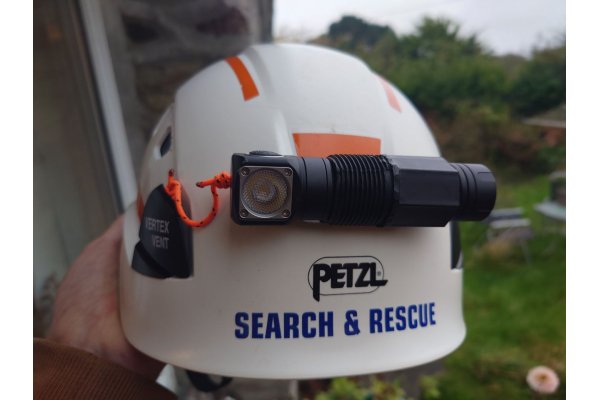
The light is powered by a single 18650 battery, providing good runtimes. It has a magnetic tailcap which I immediately remove, and a TIR lens which gives a smooth, even beam distribution. It also has a lockout and moonlight mode.
You'll get one for about £35, before batteries and charger. Don't get the RC version with built-in charging.
Here's a review from the excellent Zero Air, which gives more detail than I ever could (although it's of the RC version).
Emisar DW4
The Emisar DW4 is a similar right angle torch with headstrap, but probably aimed more at enthusiasts, as you can choose your own emitters and drivers to get exactly the light you want. You can also get a floody optic, which I've not tried, as the standard optic is nice enough anyway. I went for a nice warm emitter, and love it, so use it as standard underground and keep the cooler Skilhunt H04 as a backup.
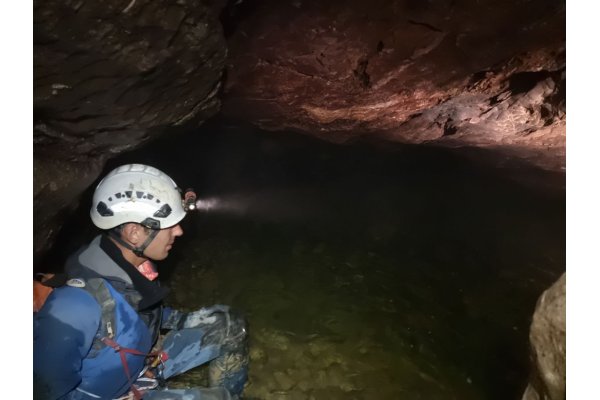
The torch uses Anduril as it's UI, which gives huge amounts of customisation potential, but has quite a steep learning curve. Again, it comes with moonlight mode and lockout. The one potential downside is that it comes with, in my opinion unnecessary, accessory LEDs that help the torch be seen when off (but parasitically draining the battery!?) and indicate battery charge etc. This is easily disabled in Anduril, so not really a problem, but I'd rather not have them.
Lumintop HL3A
I've only recently started playing with the Lumintop HL3A, which I ordered in the process of writing this post. My initial impressions are good, I like the build quality, form factor, and robustness. I have found, however, that there is significant parasitic drain, which means that if you leave the torch sitting around with the battery in it for any length of time between trips then it'll drain the battery down. The simple solution to this is to insert a small plastic shim between the battery and contacts when not in use (which is a good idea anyway) but this is added faff, so it's definitely a bit of a turn-off.
Annoyingly the only one available to purchase in the UK uses the Cree XP-L Hi "cool white" emitters, which I suspect is around the 5700K mark, and is much cooler than my preference.
Close contenders
I don't recommend these, because they don't quite meet my requirements, however many are still very good lights for other use cases. As such, they're worth including so that I can talk about why I don't like them for caving.
Fenix HM62-T
The Fenix HM62-T is marketed as a no-nonsense trail running headtorch, and this means that it shares many similarities with my ideal caving torch. UK cavers seem to like Fenix as a brand, so I'm glad I can include one as a close contender, and this one is pretty good. It has electronic lockout, a sensible selection of brightnesses, and is very robust. It even comes with a refreshingly warm default colour temperature of 4500-5000K which is excellent!
For what it is I think it's a little expensive, and I don't appreciate throwing in red LEDs and flashing modes, but I can live with all of that. I don't actually own one, so I can't test this, but I do worry slightly about how the patented tension adjuster might hold up to muddy caving environments, so a better headstrap would make it more appealing to me, but I like the addition of a whistle.
Zebralight H600F Mk IV
The Zebralight H600F Mk IV is probably the most "premium" of my suggestions, and as such I don't own one. They're also despicably difficult to buy in the UK as there are so many different configurations that very few distributors stock them all.
I would probably lean towards the H600Fd because I like the emitter colour and CRI.
Zebra has an excellent reputation for build quality, to the extent that they pot their circuitry for improved water resistance, but they have one huge drawback: no electronic lockout. This leaves the torch liable of turning on in your tackle sack, so when you need it most it's out of juice (or has melted your lunch). As such I won't be buying one any time soon.